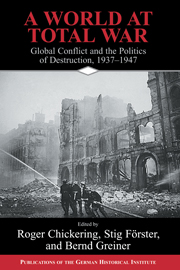Book contents
- Frontmatter
- Are We There Yet? World War II and the Theory of Total War
- Part A The Dimensions of War
- Part B Combat
- 4 Germany and the Battle of the Atlantic
- 5 From “Blitzkrieg” to “Total War”: Germany’s War in Europe
- 6 Global Yet Not Total: The U.S. War Effort and Its Consequences
- Part C Mobilizing Economies
- Part D Mobilizing Societies
- Part E The War against Noncombatants
- Part F Criminal war
- Index
5 - From “Blitzkrieg” to “Total War”: Germany’s War in Europe
Published online by Cambridge University Press: 05 January 2013
- Frontmatter
- Are We There Yet? World War II and the Theory of Total War
- Part A The Dimensions of War
- Part B Combat
- 4 Germany and the Battle of the Atlantic
- 5 From “Blitzkrieg” to “Total War”: Germany’s War in Europe
- 6 Global Yet Not Total: The U.S. War Effort and Its Consequences
- Part C Mobilizing Economies
- Part D Mobilizing Societies
- Part E The War against Noncombatants
- Part F Criminal war
- Index
Summary
The Second World War has commonly been portrayed as the foremost example of total warfare, while Blitzkrieg has been seen as the form of warfare that Germany waged between 1939 and 1941. This essay examines both of these assumptions. Both terms originated between the wars and have since been used imprecisely by journalists, popular writers, politicians, soldiers, and historians. In Nazi Germany, neither Blitzkrieg nor total war represented a unified concept or a body of coherent doctrine before 1939. When Hitler and German military leaders spoke of “quick knockout blows,” “lightning action,” “surprise assaults,” or of “Blitzkrieg” itself, as General Ludwig Beck did in his oft-cited memorandum of July 16, 1938, they were referring to speedy operations against Czechoslovakia and Poland. “It was victory,” Hew Strachan has written in connection with the campaign in France, “that gave Blitzkrieg the status of doctrine.” Michael Geyer, on the other hand, has argued that Blitzkrieg lived off “operational management,” which had devoured “professional strategy.” Some historians have even claimed that Blitzkrieg was not only an operational, but also a strategic and economic concept. Others have concluded that Germany never embraced a comprehensive Blitzkrieg strategy. Although the term has been attributed to Hitler himself, he distanced himself from it in November 1941. “I have never used the word Blitzkrieg,” he told his old comrades in speaking of Operation Barbarossa, “because it is a very stupid word. If it has any meaning in regard to one of the campaigns at all, then it would have to be this one.”
- Type
- Chapter
- Information
- A World at Total WarGlobal Conflict and the Politics of Destruction, 1937–1945, pp. 89 - 108Publisher: Cambridge University PressPrint publication year: 2004
- 1
- Cited by



